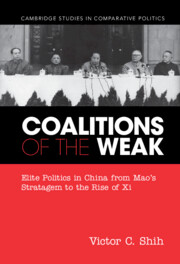Book contents
- Coalitions of the Weak
- Cambridge Studies in Comparative Politics
- Coalitions of the Weak
- Copyright page
- Dedication
- Contents
- Figures
- Tables
- Acknowledgments
- 1 Introduction
- 2 Coalition of the Strong
- 3 “Counterrevolutionary Splittists” in Mao’s Ruling Coalition
- 4 The Scribblers Mafia
- 5 Realizing the Coalition of the Weak
- 6 The Collapse of the Coalition of the Weak and Power Sharing in the 1980s
- 7 Weak Successors
- 8 Conclusion and the Future of the Chinese Communist Party
- References
- Index
3 - “Counterrevolutionary Splittists” in Mao’s Ruling Coalition
Published online by Cambridge University Press: 26 May 2022
- Coalitions of the Weak
- Cambridge Studies in Comparative Politics
- Coalitions of the Weak
- Copyright page
- Dedication
- Contents
- Figures
- Tables
- Acknowledgments
- 1 Introduction
- 2 Coalition of the Strong
- 3 “Counterrevolutionary Splittists” in Mao’s Ruling Coalition
- 4 The Scribblers Mafia
- 5 Realizing the Coalition of the Weak
- 6 The Collapse of the Coalition of the Weak and Power Sharing in the 1980s
- 7 Weak Successors
- 8 Conclusion and the Future of the Chinese Communist Party
- References
- Index
Summary
During his ascent to power in the 1930s, 1940s, and 1950s, Mao had “packed” the CCP upper echelon with people who had sided with him in the many internal power struggles in the party, especially those who had served with him in the First Front Army. Yet even this strategy was insufficient to maintain Mao’s absolute power in the party. When the unexpected shock of the Great Leap Forward led to a precipitous fall of Mao’s prestige within the party, a rival coalition composed of Mao’s former allies emerged to sideline him. Even a formerly loyal protégé such as Deng Xiaoping began to display streaks of independence.
Keywords
- Type
- Chapter
- Information
- Coalitions of the Weak , pp. 55 - 80Publisher: Cambridge University PressPrint publication year: 2022

